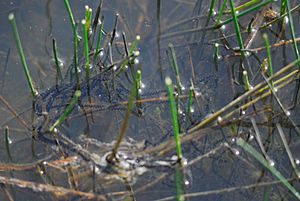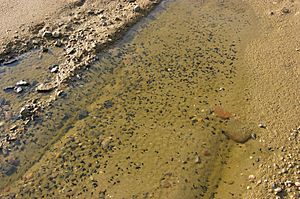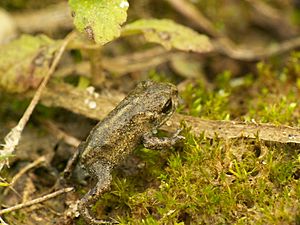Natterjack toad facts for kids
Quick facts for kids Natterjack toad |
|
|---|---|
 |
|
| Conservation status | |
| Scientific classification | |
| Genus: |
Epidalea
|
| Species: |
calamita
|
 |
|
| Synonyms | |
|
|
The natterjack toad (scientific name: Epidalea calamita) is a special kind of toad. It lives in sandy areas and heathlands across Europe. These toads are usually about 60–70 mm (2.4–2.8 inches) long. You can tell them apart from other toads by a bright yellow line down the middle of their back. They also have special glands called paratoid glands that run parallel to each other.
Natterjack toads have short legs. This makes them walk in a unique way, almost like they are running. This is different from how many other toads hop around. Male natterjack toads have a very loud and clear mating call. They have a single vocal sac under their chin that makes their call even louder!
Contents
Life of a Natterjack Toad
Natterjack toads can live for up to 15 years. They mostly eat insects, especially beetles. At night, they like to move around in open places where there isn't much plant life. You can often see their tracks in loose sand. They can travel quite far each night. This helps them find and settle in new homes very quickly.
Natterjack Toad Reproduction
Natterjack toads lay their eggs, called spawn, between late April and July. They lay long strings of eggs in shallow, warm pools of water. Since there aren't always many natterjack toads in one place, their loud mating calls are very important. The calls help male and female toads find each other to mate.
The pools where natterjacks lay eggs need to be just right. They should have a very gentle slope and not many plants in or around the water. These kinds of pools are often temporary. This means they can sometimes dry up, which can cause the tadpoles to die. To make up for this risk, natterjack toads mate over a long period each summer. So, by September, young toads can be different ages, from one to three months old. Toads that breed early in the season usually don't breed again later. However, some female toads might lay eggs twice in one year.
Where Natterjack Toads Live
Natterjack toads live in 17 different countries across Europe. In the UK, you can mostly find them near the coast. The natterjack is the only type of toad that naturally lives in Ireland. In Ireland, they are found in County Kerry (on the Dingle Peninsula and in Derrynane). They were also brought to a sand dune area in County Wexford.
In other parts of Europe, especially in the south, natterjack toads live further inland. They can be found in many different types of habitats there.
Protecting Natterjack Toads
Protecting Toads in the UK
In the UK, the natterjack toad is a threatened species. Because of this, it is part of a special plan called the United Kingdom Biodiversity Action Plan. This plan aims to protect it and two other amphibians. Here are some reasons why natterjack toads are threatened:
- They are losing their homes because of too many people.
- Their lowland heathland homes are getting worse or disappearing.
- Coastal areas where they live are shrinking due to things like dykes and seawalls.
- Their water homes are becoming too acidic from acid rain and other pollution.
In England, many of the toad's sand dune homes are protected. These are called national nature reserves. For example, in the northwest, you can find reserves at Hoylake, Ainsdale Sand Dunes, North Walney, and Sandscale Haws. In Scotland, where these toads only live near the Solway Firth, there is a reserve at Caerlaverock. Natterjack toads disappeared from Wales in the 20th century. But they have been brought back as part of the Biodiversity Action Plan.
Protecting Toads in Ireland
To help stop the loss of their homes, the National Parks and Wildlife Service in Ireland has built new ponds for the toads. They received some money from the Heritage Council for this. The natterjack toad is considered endangered in Ireland. As of July 2021, a project involving Fota Wildlife Park and the National Parks and Wildlife Service has released 6,000 young toads into their natural homes in County Kerry.
See also
 In Spanish: Sapo corredor para niños
In Spanish: Sapo corredor para niños






